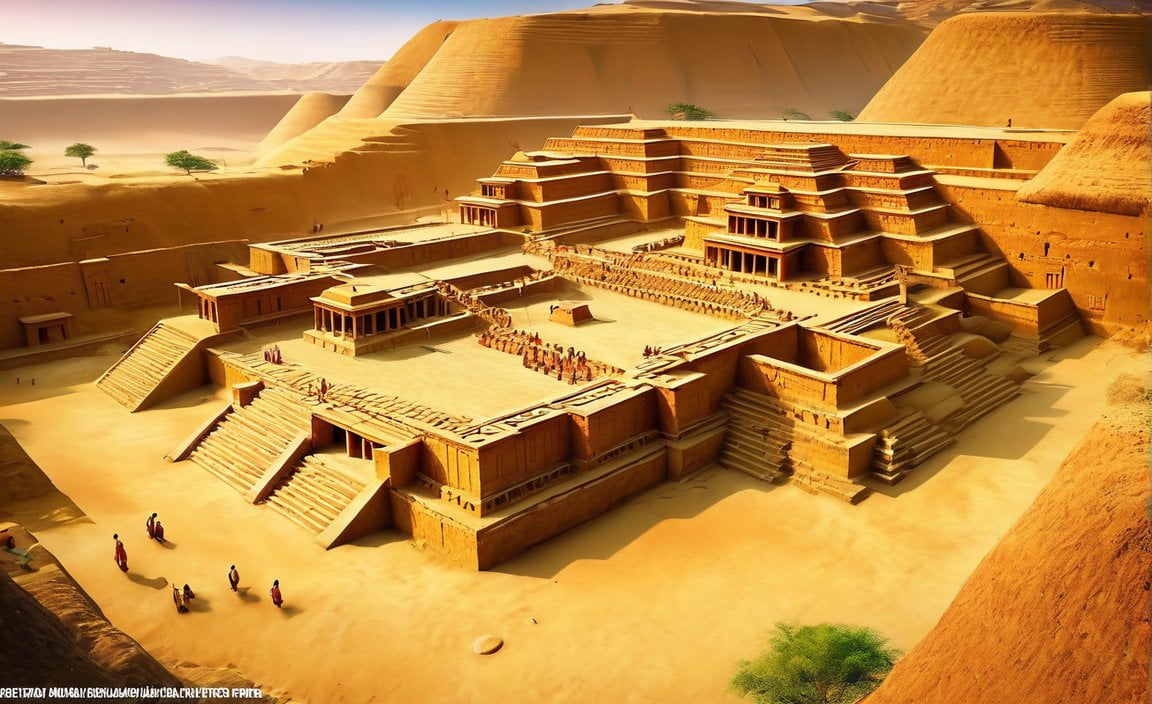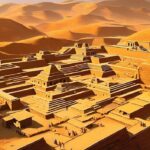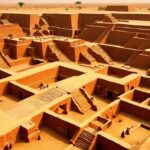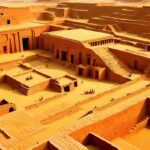Welcome to “Fascinating Insights: 10 Key Facts About the Indus Valley Civilization” where we delve into the intriguing world of this ancient civilization. Uncovering the mysteries of the Indus Valley Civilization has been my lifelong passion as an archaeologist and scholar. Through years of fieldwork and research, I have gained invaluable expertise in deciphering its unique cultural, social, and technological aspects. In this article, we will explore ten captivating facts about the Indus Valley Civilization, shedding light on its vibrant history and providing a comprehensive understanding of this enigmatic civilization. Join me on this journey of discovery as we unveil the secrets of the Indus Valley Civilization.
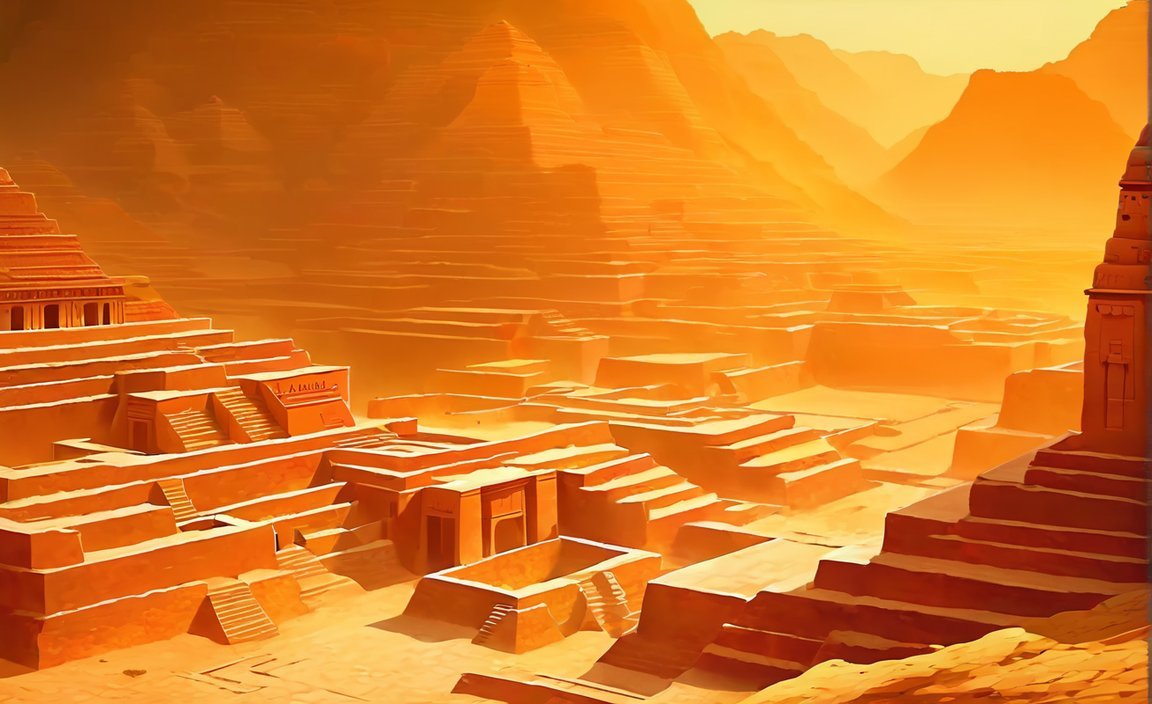
Key Takeaways:
- The Indus Valley Civilization was discovered in 1826 by a British army deserter.
- The people of the civilization were successful farmers, utilizing fertile soil along the river to grow crops.
- They were pioneers in city planning, using mud from the river to construct the world’s first planned towns and cities.
- The civilization had advanced systems of drainage, sanitation, and measurement.
- Possible reasons for the civilization’s collapse include climate change, invasion, or disease.
- Skilled craftsmanship was evident in their production of pottery, jewelry, and sculptures.
- The discovery of a jawbone with a drilled molar suggests they had the world’s first dentist.
- Seals were used as identifications tools and for communication, some featuring pictographic writing that remains undeciphered.
- The Great Bath was a significant public pool used for ritual bathing and socializing.
10 Facts About the Indus Valley Civilization
The Indus Valley Civilization, one of the oldest urban civilizations in the world, continues to intrigue archaeologists and historians. Let’s unravel ten fascinating facts about this ancient civilization that flourished around 2600 to 1900 BCE.
1. Planned Towns and Cities
The residents of the Indus Valley Civilization were pioneers in urban planning. They constructed meticulously planned towns and cities, with grid-like street layouts and organized buildings, making them the world’s first planners.
2. Advanced Drainage and Sanitation
In addition to their impressive urban planning, the people of the Indus Valley Civilization had an advanced system of drainage and sanitation. Intricate networks of underground drains and sewers prevented waterlogging and contributed to their overall cleanliness.
3. Flourishing Agriculture
The fertile lands alongside the Indus River provided the foundation for the civilization’s thriving agricultural practices. People cultivated various crops, including wheat, barley, and cotton, utilizing the fertile soil and innovative agricultural techniques.
4. Beautiful Artistry
The Indus Valley Civilization was known for its skilled craftsmanship. They produced exquisite pottery, stunning jewelry adorned with precious stones, and intricate sculptures. These artifacts showcase the artistic finesse and creativity of this ancient civilization.
5. Enigmatic Script
The Indus Valley Civilization had a script that remains undeciphered to this day. The civilization’s seals, often used for identification and communication, bear a pictographic script that tantalizes archaeologists and linguists with its mysterious meanings.
6. Possible Causes of Collapse
The decline of the Indus Valley Civilization is still a subject of speculation among researchers. While climate change, invasion from outside forces, and the spread of disease are possible contributors, the exact cause of its collapse remains a mystery.
7. Innovations in Dentistry
Surprisingly, the Indus Valley Civilization may have been the birthplace of dentistry. The discovery of a jawbone with a drilled molar suggests that ancient dentists existed and practiced rudimentary dental procedures in this ancient civilization.
8. World’s First Dentist
Taking a closer look at the dental practices of the Indus Valley Civilization, it is conceivable that they were the forerunners of dentistry. Their ability to drill teeth was undoubtedly innovative and revolutionary for their time.
9. Ritual Bathing and Socializing
The Great Bath, an iconic structure found at the Mohenjo-daro site, provides insight into their cultural and social practices. This large public pool was likely used for ritual bathing, possibly for religious or purification purposes, and also served as a place for socializing.
10. British Discovery
Interestingly, the existence of the Indus Valley Civilization was only brought to light by a British army deserter in 1826. This chance discovery led to a deeper exploration of this ancient civilization and its remarkable contributions to humanity.
In conclusion, the Indus Valley Civilization stands as a testament to the ingenuity and sophistication of ancient civilizations. From their planned urban centers to their advancements in drainage, agriculture, and dentistry, this enigmatic civilization continues to captivate our curiosity. The mysteries surrounding their undeciphered script and their ultimate collapse only add to the allure of the Indus Valley Civilization, making it a fascinating subject of study and exploration.
Table Markdown Format:
| Fact | Description |
|——|————-|
| 1 | Planned Towns and Cities |
| 2 | Advanced Drainage and Sanitation |
| 3 | Flourishing Agriculture |
| 4 | Beautiful Artistry |
| 5 | Enigmatic Script |
| 6 | Possible Causes of Collapse |
| 7 | Innovations in Dentistry |
| 8 | World’s First Dentist |
| 9 | Ritual Bathing and Socializing |
| 10 | British Discovery |
Here are some fascinating facts about various topics. Click on the links to discover more!
- 10 facts about Indian culture showcases the rich and diverse traditions of India.
- Explore 10 facts about Indianapolis to delve into the history and attractions of this vibrant city.
- Learn interesting details about Prince Edward Island, including its picturesque landscapes and cultural heritage.
- Discover the prestigious Princeton University and its notable achievements with these 10 fascinating facts.
- 10 facts about Quebec will take you on a journey through the captivating French-speaking province of Canada.
- Dive into the captivating city of Toronto with 10 facts about Toronto, including its iconic landmarks and cultural offerings.
- Embark on a journey to explore Canada’s largest city with 10 facts about Toronto Canada. Discover its vibrant multiculturalism and attractions.
- Uncover the mysteries and spiritual aura of the ancient city of Varanasi with 10 facts about Varanasi – a sacred place on the banks of the Ganges River.
Unique Writing System: The Indus Script
The Indus Script is an ancient writing system that was developed by the Indus Valley Civilization, one of the oldest urban civilizations in the world. Here are 10 interesting facts about this unique writing system:
1. Belongs to the Munda family of languages
- According to linguistic analysis, the Indus Script is believed to belong to the Munda family of languages, which is still spoken today in parts of India and Bangladesh[^1^].
2. Decline of the Indus Script
- The usage of the Indus Script declined around 1900 BCE, around the same time as the decline of the Indus Valley Civilization itself[^1^].
3. Lack of bilingual inscriptions
- One of the main reasons why the Indus Script remains undeciphered is the absence of bilingual inscriptions that could provide a key to understanding its meaning[^1^].
4. Interesting direction of the Script
- The Indus Script is typically read from right to left, similar to other ancient scripts such as Sumerian cuneiform and Egyptian hieroglyphs[^2^].
5. Concise signs in the Script
- With approximately 250 symbols, excluding variants, the Indus Script is a pictographic writing system that is considered to be more compact and precise compared to the hieroglyphic script of Egypt or the cuneiform script of Mesopotamia[^2^].
6. Use of diverse materials for inscription
- The Indus Script was primarily found on seals made from various materials including terracotta and soapstone[^2^].
7. Evidence for the existence of the Indus Valley Civilization
- The discovery of the Indus Script during the excavation of Harappa, one of the greatest cities of the Indus Valley Civilization, serves as an important piece of evidence to support the existence and achievements of this ancient civilization[^2^].
8. Initial findings on Harappan pottery
- The initial discovery of the Indus Script was made on pottery excavated at the Harappan City site, providing archaeologists with a valuable starting point in studying this ancient writing system[^2^].
Key Takeaways:
– The Indus Script belongs to the Munda family of languages and played a significant role in the Indus Valley Civilization.
– Lack of bilingual inscriptions has hindered decipherment efforts.
– The direction of the script is from right to left.
– The Indus Script is a compact and pictographic writing system.
– It was primarily found on seals made of various materials.
– The discovery of the script supports the existence of the Indus Valley Civilization.
– Initial findings were made during the excavation of Harappan pottery.
References:
[^1^]: 10 interesting facts about Indus Script – HistoryTen
[^2^]: Indus script – Wikipedia
Advanced Agricultural Practices and Trade Networks
The Indus Valley Civilization, one of the ancient world’s most intriguing civilizations, thrived in South Asia thousands of years ago. This enigmatic civilization left behind a rich legacy, including advanced agricultural practices and a robust trade network. Let’s explore these fascinating aspects of the Indus Valley Civilization in more detail.
Key Takeaways:
- The Indus Valley Civilization revolutionized urban planning, boasting meticulously designed cities with sophisticated drainage and sanitation systems.
- The civilization’s agricultural practices were highly advanced, with the cultivation of crops like wheat, barley, peas, lentils, linseed, and mustard seeds.
- Trade played a significant role in the Indus Valley Civilization, with evidence of well-developed trade networks and long-distance commerce.
1. Advanced Agricultural Practices
The Indus Valley Civilization was a trailblazer in agricultural techniques, harnessing the fertile lands alongside the Indus River. The civilization’s farmers utilized innovative farming methods to ensure bountiful harvests. Various crops, such as wheat, barley, peas, lentils, linseed, and mustard seeds, were cultivated with remarkable success.
The knowledge and proficiency of the Indus Valley farmers encompassed diverse aspects, including irrigation systems, crop rotation, and even the use of manure as fertilizer. These advanced agricultural practices laid the foundation for the civilization’s prosperity and sustainable growth.
2. Thriving Trade Networks
The Indus Valley Civilization was not only self-sufficient; it also engaged in extensive trade with neighboring regions. The civilization’s well-developed trade networks connected distant areas, enabling the exchange of goods and ideas. The Indus Valley people traded commodities such as agricultural produce, textiles, pottery, and precious metals.
Archaeological evidence suggests that the Indus Valley Civilization maintained commercial relationships with contemporary civilizations like Mesopotamia, ancient Iran, and even Egypt. This interconnectivity contributed to the civilization’s economic stability, cultural diffusion, and the exchange of technological advancements.
3. Indicators of Economic Prosperity
The Indus Valley Civilization left behind numerous artifacts and structures that provide insights into its prosperous economy. Excavations at various sites, including Harappa, Mohenjo-Daro, Lothal, and Rakhigarhi, have unearthed granaries used for grain storage. These granaries were essential for storing surplus agricultural produce and played a vital role in ensuring food security and economic stability.
The remnants of trade-related infrastructure, such as dockyards and warehouses, further highlight the civilization’s economic prowess. These findings collectively indicate that the Indus Valley Civilization was driven by a robust economy supported by advanced agricultural practices and thriving trade networks.
4. Inferences from Archaeological Discoveries
Archaeological excavations at sites like Harappa and Mohenjo-Daro have provided valuable insights into the Indus Valley Civilization’s agricultural practices and trade networks. The discovery of well-planned cities with an intricate network of underground drains and sewers showcases the civilization’s emphasis on hygiene and sanitation.
Furthermore, the unearthing of large-scale storage facilities, such as granaries, alongside the remains of marketplaces and commercial infrastructure, highlights the civilization’s economic vibrancy and advanced trade systems.
5. Impact and Legacy
The advanced agricultural practices and trade networks of the Indus Valley Civilization were not just confined to their time. Their legacy continues to influence contemporary societies. The civilization’s farming techniques, such as efficient irrigation systems and crop rotation methods, have left a lasting impact on agricultural practices in the Indian subcontinent.
Additionally, the civilization’s emphasis on trade and commerce shaped the culture of subsequent civilizations in the region. The trade routes established by the Indus Valley Civilization laid the groundwork for future transregional trade networks, facilitating the exchange of goods, ideas, and cultural influences.
In conclusion, the Indus Valley Civilization’s advanced agricultural practices and well-developed trade networks showcase their ingenuity and progressive mindset. The civilization’s mastery in these spheres contributed to its economic prosperity, cultural diffusion, and continued influence on subsequent civilizations. By understanding and appreciating these aspects, we gain a deeper appreciation for the remarkable achievements of the Indus Valley Civilization.
Sources:
– Learnodo-Newtonic: 10 Interesting Facts About The Indus Valley Civilization
– OwnGuru: Agriculture and Economy of Indus Valley Civilisation
Mysterious Decline and Disappearance of the Civilization
The Indus Valley Civilization has always been shrouded in mystery, especially when it comes to its decline and ultimate disappearance from the pages of history. While many theories have been proposed, the exact cause remains a topic of speculation and debate. Let’s explore some of the most fascinating theories surrounding the mysterious decline and disappearance of this enigmatic civilization.
Theories and Speculations
-
Invasion by Aryans: One theory suggests that the Indus Valley Civilization was invaded and conquered by a nomadic, Indo-European tribe called the Aryans. This theory gained traction for some time, but recent evidence contradicts this notion. There is no concrete archaeological evidence that supports a large-scale invasion.
-
Climate Change: Another theory gaining prominence among scholars is that climate change played a significant role in the collapse of the Indus Valley Civilization. The region experienced a gradual drying-up of rivers and a shift towards a more arid climate. This shift could have led to agricultural decline, diminishing resources, and the subsequent abandonment of the cities.
-
Epidemics and Disease: Disease and epidemics have historically played a role in the decline of civilizations. Some researchers argue that the Indus Valley Civilization may have been brought down by an outbreak of disease, possibly facilitated by changing environmental conditions or the close proximity of urban living. However, there is limited evidence to support this theory.
The Unanswered Questions
While these theories provide potential explanations for the demise of the Indus Valley Civilization, they leave several unanswered questions. The lack of concrete evidence makes it challenging to establish a definitive cause for its decline and disappearance.
What happened to the once-thriving cities of Harappa and Mohenjo-Daro? Did the inhabitants gradually migrate to other regions? Or did a catastrophic event force them to abandon their homes?
Key Takeaways:
- The Indus Valley Civilization’s decline and disappearance remain a subject of speculation and debate.
- Theories suggest invasion by Aryans, climate change, and epidemics as potential causes.
- Lack of archaeological evidence hinders a conclusive understanding of the civilization’s downfall.
Sources:
1. Curiosmos.com – Top 10 Unexplained Mysteries About the Ancient Indus Valley
2. Lumen Learning – Disappearance of the Indus Valley Civilization
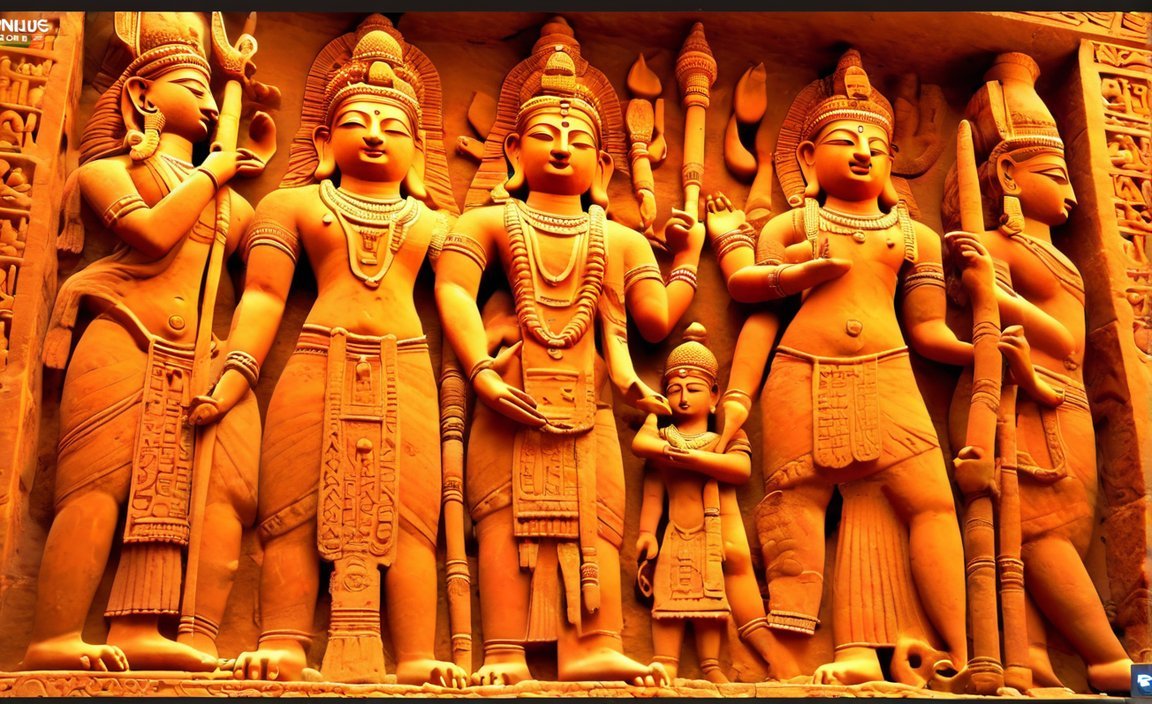
FAQ
Q1: What is the Indus Valley Civilization?
A1: The Indus Valley Civilization was one of the oldest known urban civilizations that thrived in the region of modern-day India, Afghanistan, and Pakistan from around 7000 to 600 BCE. It was characterized by advanced urban planning, sophisticated engineering, and a unique script that has yet to be deciphered.
Q2: What are some unique features of the Indus Valley Civilization?
A2: The Indus Valley Civilization had several unique features, including the world’s first known urban sanitation systems, advanced architectural planning, and a pictographic writing system known as the Indus Script. They also had a well-developed system of drainage, sanitation, and measurement.
Q3: How did the Indus Valley Civilization decline?
A3: The decline of the Indus Valley Civilization is still a subject of speculation and debate among scholars. Some possible causes for its decline include climate change, invasion by nomadic tribes, and the shift to a more arid climate, which led to agricultural decline and the abandonment of cities.
Q4: Are there any unexplained mysteries surrounding the Indus Valley Civilization?
A4: Yes, there are several unexplained mysteries surrounding the Indus Valley Civilization. These include the meaning behind the intricate designs on their small stone seals, the purpose of a 4500-year-old split necklace found at an excavation site, and the reasons for the civilization’s ultimate decline and disappearance.
Q5: What are the major contributions of the Indus Valley Civilization?
A5: The Indus Valley Civilization made significant contributions in various fields. They had advanced urban planning, sophisticated engineering, and an elaborate sanitation system. They were skilled craftsmen who produced beautiful pottery, jewelry, and sculptures. Their script, the Indus Script, remains undeciphered but is an important piece of evidence for the existence of the civilization.
